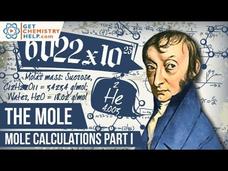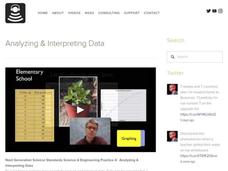TED-Ed
Why Should You Read Edgar Allan Poe?
Edgar Allen Poe's writing goes far beyond the familiarity of "The Raven" and "The Tell-Tale Heart." An intriguing video lesson explores the work, history, and style of the famous Gothic writer. Animations engage viewers in the video, and...
TED-Ed
Building the Seed Cathedral
Watch this inspiring TED Talk by architect Thomas Heatherwick on the creation of the Seed Cathedral. Heatherwick tells a story of innovation and sustainability through displaying five recent projects his firm has worked on. Your learners...
Veritasium
Khan Academy and the Effectiveness of Science Videos
Do science videos really enhance learning? Pupils examine the facts in a video about videos. The narrator shows how science scholars perform on a quiz after watching a related video, then how they perform on the same quiz after watching...
TED-Ed
What Can Herpes Do To Your Brain?
As if the herpes virus isn't gross enough! A video lesson explains how the herpes virus hides in neurons in the nervous system. Learners discover how the latent virus reappears in susceptible immune systems.
Amoeba Sisters
Alleles and Genes
How do organisms end up with such a wide variety of traits? It's in their genes! Kick off your inherited traits lesson using a brief video that covers alleles and genes. The narrator describes heterozygous and homozygous genotypes, how...
Macat
An Introduction to Lave and Wenger's Situated Learning
Learning begins with observation. A video summary of Lave and Wegner's Situated Learning discusses the importance of observation and apprenticeship in learning as part of a larger playlist on the world's greatest ideas. The video...
Smithsonian Institution
Make It Rain!
Consistent analysis of teaching and learning is important to growth in the profession. A video lesson—paired with a discussion guide—encourages teachers to consider their strategies for teaching phase changes and the water cycle. The...
Smithsonian Institution
Falling 101
Although gravity is something everyone experiences, many have misconceptions tied to the concept. A PD lesson from the Good Thinking series explores misconceptions and how to correct them. The lesson also offers ideas for demonstrations...
Curated OER
RC Truck Safety
Are any of your students into RC trucks? The student in this video provides viewers with tips about charging, driving, and caring for an RC truck.
Get Chemistry Help
Chemistry Lesson: Double Displacement Reactions
What is the best method to teach your chemistry class about double displacement reactions? Dr. Kent discusses this topic, including double replacement reactions, metathesis reactions, and exchange reactions, using rules of...
Get Chemistry Help
Chemistry Lesson: Acid-Base Neutralization Reactions
Provide your emerging chemists with the most descriptive way to perform specialized double displacement reactions possible! This video details acid-base neutralization, where acids and bases are combined to result in salt and water...
Get Chemistry Help
Chemistry Lesson: The Mole (Avogadro's Number)
Avagodro's number (The Mole) ... you are not researching that cute little mole on your cheek! Avagodro's number refers to The Mole, a vital component to chemistry. This video segment will discuss the mole and further elaborate on...
Get Chemistry Help
Chemistry Lesson: Molar Mass
Enhance your current chemistry curriculum with a short video that demonstrates how to calculate the molar mass of a compound. There is also instruction for conversion between moles and mass, outlined in simple steps and demonstrated in a...
Get Chemistry Help
Chemistry Lesson: Mole Calculations I
Do your pupils already have knowledge of moles and mass? If so, this is the next step for the chemistry classroom. The video segment, while short in length, is filled with demonstrations on how to perform mole calculations involving both...
Get Chemistry Help
Chemistry Lesson: Determining Formula from Composition Data
Searching for a quick and thorough video segment to enhance your chemistry classroom? A step-by-step process determines the empirical and molecular formula of chemical compounds. A periodic table is required to properly integrate...
Get Chemistry Help
Chemistry Lesson: Unit Analysis (Unit Conversions)
An informative video offers detailed instruction of the proper way to convert between different units in the English and metric systems. Additionally, it provides an explanation of how to handle significant digits and when this...
Get Chemistry Help
Chemistry Lesson: Compound Unit Conversions
Searching for a way to enhance your classroom chemistry curriculum? A short video segment offers detailed instructions for how to convert compound units, such as miles/hour or milligrams/mL. The worksheet included prompts learners to...
Get Chemistry Help
Chemistry Lesson: Balancing Chemical Equations
An informative video segment describes how to balance chemical equations. It ensures pupils will obey the laws of conservation of mass and shares tips to assist young chemists who may need additional help to ensure a more simplistic...
Get Chemistry Help
Chemistry Lesson: Types of Chemical Reactions
A descriptive video segment details five types of chemical reactions, including synthesis, decomposition, single displacement, double displacement, and combustion. It is engaging for even the most discerning young chemists.
Bozeman Science
NGSS: Developing and Using Models
The Next Generation Science Standards list Developing and Using Models as the second science and engineering practice. The video explains conceptual models and the expectations for K-12th grade scholars. It highlights the progression of...
Bozeman Science
Next Generation Science Standards Introduction
Scientists and science teachers created the Next Generation Science Standards. A video provides an overview of the ideas, practices, and concepts covered in the Next Generation Science Standards, explaining the differences in each and...
Bozeman Science
NGSS: Asking Questions and Defining Problems
The first practice covered in the Next Generation Science Standards is learning to ask questions and define problems. The video focuses on the similarities and differences between science and engineering focusing on this practice. It...
Bozeman Science
NGSS: Planning and Carrying Out Investigations
The Next Generation Science Standards incorporate planning and carrying out investigations as the third practice. An informative video details how investigations benefit science and engineering, and highlights effective ways to form a...
Bozeman Science
NGSS: Analyzing and Interpreting Data
The third practice in the Next Generation Science Standards applies analyzing and interpreting data. The video explains why this is important to scientists and many different ways to organize data. Then it moves on to discuss how to...
Other popular searches
- Educational Technology
- Educational Videos
- Educational Software
- Educational Career Resources
- Educational Site
- Educational Television
- Educational Toys
- Educational Statistics
- Educational Games
- +Educational +Toys
- Educational Web Directories
- Educational Goals























